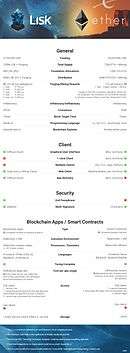Lisk
 Lisk | |
| Developer(s) | Max Kordek, Olivier Beddows |
|---|---|
| Initial release | 24 May 2016 |
| Stable release |
0.4.0
/ 10 October 2016 |
| Development status | Active |
| Written in | Node.js |
| Operating system | Clients available for Linux, Docker. Lite (Nano) client for all systems available. |
| License | MIT |
| Website | https://lisk.io |
Lisk is a public blockchain platform that provides decentralized blockchain apps. It was forked from Crypti by Max Kordek and Olivier Beddows in early 2016.[1][2]
History
Lisk started as a fork of Crypti beginning with an ICO (Initial Coin Offering) to decide the initial distribution and raise development funds. The ICO raised $5.8 million and, at the time, was the second most successful cryptocurrency crowdfund (later that month, WAVES and The DAO would surpass it).[3][4] On May 24, 2016, the mainnet for Lisk went live and it became available for trading on major exchanges.[5] Quickly after trading started, Lisk briefly became the second most popular cryptocurrency traded against Bitcoin.[6][7]
Blockchain Applications
Lisk aims to be the first (successful) of its kind as a modular cryptocurrency.[8][9] The idea is that every Blockchain App is on its own sidechain, separate from the main blockchain. This should help with scalability issues that many cryptocurrencies were facing, such as bitcoin. The sidechain is secured by a group of 101 master nodes elected by the app's owner, and operate using the same Delegated-proof-of-stake (DPoS) consensus mechanism as the parent Lisk network. The Blockchain Apps are written using NodeJS/JavaScript on the backend and CSS3/HTML5/JavaScript for the frontend.[10]
DPoS Design
Lisk uses the DPoS (Delegated Proof of Stake) algorithm originally created by BitShares.[11] What differentiates it from regular PoS (Proof of Stake) is that only the top 101 delegates (determined by voting weight of voters) are actively forging and securing the network.
Lisk DPoS functions through a series of rounds. Rounds consist of 101 individual blocks. Each of the 101 active delegates are randomly assigned 1 block within the round to forge. A full cycle round takes 17 minutes. If a selected delegate is unable to forge their assigned block, activity from that block moves to the next block in the round.[12]
Block Time
The Lisk network forges blocks in 10s intervals. In the event that a delegate fails to properly forge their assigned block, the transactions move to the next block in the round, causing the block to be extended by 10s. Each subsequent missed block results in a 10s delay for transaction processing and confirmations.
Forging
Lisk utilizes an inflationary forging rewards system which creates new LSK for every successful block. During year 1, the forging rewards are set at 5 LSK per block. Every 3,000,000 blocks (~1 year) forging rewards are reduced by 1 LSK, ending at 1 LSK per block after 5 years. The forging rewards will then stay at 1 LSK per block indefinitely.[12] The Forging Rewards will be equally distributed through all active (top 101) delegates, same as any network fees.
Distinctions from other cryptocurrencies
Lisk is commonly compared to Ethereum and Crypti, so it is important to note their differences.

Differences from Ethereum
Lisk and Ethereum both try to provide a platform for a similar idea: Decentralized Applications (Lisk calls them Blockchain Applications[13])
- Lisk is an all-around Blockchain (Decentralized) Application platform, that allows for endless possibilities on the developers and/or entities end to build and create, while Ethereum is a platform that only allows for Smart Contract based projects to be created, which in the end limits the overall potential of a set-goal that individuals project can reach or obtain.
- Lisk uses DPoS, while Ethereum currently uses PoW (they have stated they plan to switch to PoS eventually).[14]
- Applications language: Lisk uses Javascript, while Ethereum currently uses Solidity.[15]
- Applications location: Lisk uses sidechains, while Ethereum currently stores it on the main chain.[16]
- Error handling: In Lisk, if your application has an issue it will be contained to only your chain, but require a hard fork to fix. In Ethereum, applications are run in a virtual machine on the main chain so any error should just result in the waste of transaction fees, but be contained to the VM (as long as there is no bug in the VM).
- Applications VM: Ethereum applications are run in the Ethereum Virtual Machine (EVM). Lisks does not have a VM, but it is in development.
Differences from Crypti
Lisk commonly compared to Crypti, because it is a fork of it. However, they have various differences:[17]
- The database has been changed from SQLite to PostgreSQL.
- Completely open source and the whole development procedure is happening in public on GitHub.
- BIP39 enforced for all passphrases
- Development is continuing and active, while Crypti seems to have stopped.
Partners
Lisk partnered with Microsoft to integrate Lisk into its Azure Blockchain as a Service (BaaS) program — meaning developers worldwide can develop, test, and deploy Lisk blockchain applications using Microsoft's Azure cloud computing platform and infrastructure.[18]
References
- ↑ "Olivier and Max leave Crypti to establish Lisk!". Lisk Blog. Max Kordek.
- ↑ "An Open Letter to the Community". Crypti. Mike. Retrieved 7 June 2016.
- ↑ "Lisk Raises Over 5.7 Million USD in 2nd Most Successful Crypto-Currency Crowd-Fund to Date". CoinDesk.
- ↑ "Second Most Successful Cryptocurrency Crowdfund". The Merkle.
- ↑ Allison, Ian. "Lisk releases modular cryptocurrency with sidechains". International Business Times.
- ↑ Buntinx, JP. "Lisk Becomes Second Most Popular Cryptocurrency Traded Against Bitcoin". The Merkle.
- ↑ "CoinCap". Coin Cap.
- ↑ Ogundeji, Olusegun. "Lisk to Move Developers from Blockchain to Sidechain". Cointelegraph.
- ↑ "Lisk Releases First Modular Cryptocurrency with Sidechains". Newsbtc.
- ↑ "Developing Apps". Lisk Documentation. Retrieved 8 June 2016.
- ↑ "Delegated Proof of Stake". BitShares.
- 1 2 "Explaining Lisk Forging Rewards". Lisk Blog. Max Kordek & Olivier Beddows.
- ↑ Kordek, Max. "Changing the Lisk Terminology. Renaming dapps to blockchain apps". Lisk Blog. Retrieved 8 June 2016.
- ↑ Davis, Wendell. "An Open Source Mining Pool Bounty and DEVgrant". Ethereum Blog. Retrieved 8 June 2016.
- ↑ "Solidity". Solidity Documentation. Retrieved 8 June 2016.
- ↑ "Contracts". Ethereum Documentation. Retrieved 8 June 2016.
- ↑ "The Difference Between Lisk and Crypti". Lisk Helpdesk.
- ↑ Gray, Marley. "Azure Blockchain as a Service Update #6". Microsoft.
External links
- Official website
- Template:LISK links